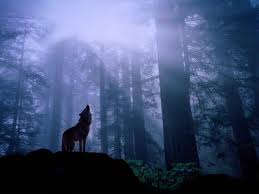 In films vampires and werewolves are often depicted1) as having a blood feud2), but in traditional folklore3) they were not necessarily bitter enemies.
In films vampires and werewolves are often depicted1) as having a blood feud2), but in traditional folklore3) they were not necessarily bitter enemies.
The werewolf and vampire are similar in many ways. They both hunt human prey4), which might make them natural rivals5). However, the werewolf and vampire myths spring from6) very different origins.
电影中常常刻画吸血鬼和狼人有家族血仇,但在传统的民间故事中,他们未必是仇敌。
狼人和吸血鬼有很多相似之处。他们都猎取人类——也许正是这点使他们成了天敌。但狼人和吸血鬼的传说有着截然不同的起源。
● Origin of the Werewolf
The werewolf appears as an ancient figure in folklore throughout the world. In Greek mythology, Lycaon displeased the deity7) Zeus, who turned him into a wolf. This is where the term lycanthropy8) originated, and is one of the oldest tales of a man turning into a wolf.
In Europe and the Late Middle Ages, belief in werewolves spread. Werewolf tales were prevalent9) in France. The French name for werewolf is loup-garou. In sixteenth century France, there were many accounts of men being tried for becoming werewolves. Incidences10) of lycanthropy have been reported throughout the world in modern as well as ancient times.
● 狼人的起源
在世界各地的民间传说中,狼人的形象自古就有。在希腊神话中,吕卡翁惹恼了天神宙斯,宙斯就把他变成了一匹狼。“变狼狂”这个词便是由此而来。这也是最早的关于人变成狼的传说之一。
在中世纪末的欧洲,狼人的确存在的观点广为流传。狼人的故事在法国十分盛行,法语中的“狼人”一词是loup-garou。在16世纪的法国,有许多关于人变成狼人而受到审判的报道。不论近现代还是古代,世界各地都有人变成狼人的报道。
● Origin of the Vampire
Vampire lore11) is varied, but usually has to do with death or is associated with the grieving process. The Lamia, a vampire of Greece, attacked children and sucked their blood after having a stillborn12) child. Vampire tales often served as a warning to those tempted13) to lead an evil lifestyle. If they were bad, they might become a vampire.
In European tales, an unexpected or sudden death, suicide, or improper funeral or burial might also cause a vampire to rise from the grave. After the death of a loved one, that person came back to attack the family. The victims of vampires suffered from nightmares and appeared to have a wasting disease14). The vampires multiplied by contaminating15) members of their family or community.
The vampire of literature was a more romantic vision of the vampire. Bram Stoker16)'s novel Dracula strongly influenced vampire myths.
● 吸血鬼的起源
吸血鬼的传说各不相同,但通常都涉及到死亡或痛苦的过程。希腊神话中的吸血鬼拉米亚在产下一个死婴后,就开始袭击孩童,吸他们的血。吸血鬼的故事常常用来警告那些受到诱惑走上邪道的人:他们如果作恶多端,就可能会变成吸血鬼。
在欧洲传说中,意外或突然死亡、自杀、不恰当的葬礼或安葬也可能会导致逝者变成吸血鬼从坟墓中出来。亲人去世后会回来袭击自己的家人。受害者受噩梦困扰,看起来像患了消耗性疾病。通过传染家人或邻居,吸血鬼的队伍不断发展壮大。
文学作品里的吸血鬼则更为浪漫。布莱姆·斯托克的小说《吸血鬼德拉库拉》深深地影响了吸血鬼的传说。
● Vrykolakas—Werewolf or Vampire?
Werewolves and vampires existed side by side in the mythologies of many cultures. Among Slavic tribes in the Balkans17), young warriors ritually transformed into wolves by the wearing of pelts18).
Over the centuries Vrykolakas lost its meaning as the rituals disappeared. By the 16th century, the meaning had changed to vampire. There was a Slavic belief that those who had been werewolves in life would become vampires after death.
● 活尸(本意指狼人)——狼人还是吸血鬼?
在许多民族的神话里,狼人和吸血鬼是一同存在的。巴尔干半岛上的斯拉夫部落中,年轻的勇士披上毛皮,通过这一仪式象征他们成了狼。
几个世纪以来,随着仪式的消失,活尸一词也失去了狼人的意思。到16世纪,这个词变成了吸血鬼之意。斯拉夫人认为,生前是狼人的死后就会变成吸血鬼。
● Blood Feud Between Vampires and Werewolves
The battle between vampires and werewolves is most evident in the 2003 film Underworld. However, a blood feud between vampires and werewolves is more of movie concept than one based on traditional legend. In legend, werewolves and vampires simply did not have much contact. In some, they shared a connection, but were not necessarily mortal enemies.
There have been allusions19) to a battle between vampires and werewolves called the Trajanic20) War (also called the Dacian War). In 101〜102 and 105〜106, there were two short wars between the Roman Empire during Trajan's rule, and the Dacian kingdom21), which had become a threat to the Empire. It was said that during that event the Dacian vampires betrayed the werewolves, which were their servants, to the Romans, and this unforgiveable act caused werewolves and vampires to become eternal enemies. Though the Trajanic War is a true part of history, the vampire and werewolf angle, of course, is only a myth.
In the popular film Twilight, the vampires and werewolves have been feuding for centuries, but have learned to coexist by means of a pact22) between them. Vampire and werewolves, it appears, may learn to tolerate23) each other, but they will probably never be the best of friends.
● 吸血鬼和狼人的血海深仇
2003年的电影《黑夜传说》将吸血鬼和狼人之间的斗争展现得淋漓尽致。但是,二者之间的血仇更多的只是电影中的一个概念,并非源于古老的传说。在传说中,狼人和吸血鬼并没有太多关联。有些传说中,他们相互有联系,但未必是死对头。
有典故提到吸血鬼和狼人之间的一场战斗,即图拉真之战(也叫达契亚之战)。公元101~102年和公元105~106年,图拉真统治的罗马帝国和对其构成威胁的达契亚王国之间爆发了两次短暂的战争。据说在战争期间,达契亚的狼人本是吸血鬼的仆从,但吸血鬼却背弃了他们投向罗马人。这一不可饶恕的行为使得狼人与吸血鬼成为永久的敌人。尽管图拉真之战在历史上确有发生,但吸血鬼和狼人的故事当然只是个神话传说。
在风靡一时的电影《暮光之城》中,吸血鬼和狼人争斗了数个世纪,但双方通过达成协定学会了共存。看起来,吸血鬼和狼人可以学着相互容忍,但可能永远无法成为好朋友。
1. depict [dI5pIkt] vt. 描写,描述
2. feud [fju:d] n. (部落或家族间的)世仇
3. folklore [5fEJklC:(r)] n. 民间传说
4. prey [preI] n. 猎物,捕获物
5. rival [5rEIvEl] n. 竞争者,对手
6. spring from: 发源于;来自
7. deity [5di:ItI] n. 神
8. lycanthropy [laI5kAnWrEpI] n.【心】变狼(妄想)狂;(传说中)用巫术(或魔术)使人变成狼
9. prevalent [5prevElEnt] adj. 流行的,盛行的;普遍的
10. incidence [5InsIdEns] n. 发生
11. lore [lC:(r)] n. (某一文化或活动领域的)全部传说.
12. stillborn [5stIlbC:n] adj. 死产的;夭折的
13. tempt [tempt] vt. 引诱,诱惑
14. wasting disease: 消耗性疾病(如结核病);痨病
15. contaminate [kEn5tAmIneIt] vt. 使……不纯净或不洁净
16. Bram Stoker: 请参阅P5编者注1。
17. the Balkans: 巴尔干半岛各国,位于欧洲南部
18. pelt [pelt] n. (羊及其他产毛皮小动物的)毛皮;(去毛的)生皮
19. allusion [E5lju:VEn] n. 典故;引用典故
20. Trajan [5treIdVEn] n. 图拉真(53?〜117),古罗马皇帝,改革财政,加强集权统治,大兴土木,修建城市、港口、桥梁和道路,发动侵略战争,向东扩张领土,直至波斯湾。
21. the Dacian kingdom: 达契亚王国。Dacia [5deIFIE] n. 达契亚,古代一地区和罗马一省份,大致相当于今天的罗马尼亚地区。
22. pact [pAkt] n. 公约,协定
23. tolerate [5tClEreIt] vt. 忍受,宽恕
